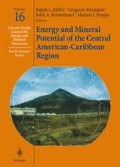Abstract
Peat deposits of Costa Rica developed in major alluvial plains of the Atlantic coast (back arc basin) and in the mountains in small depressions of the magmatic arc.
The peat swamps of the Caribbean coastal plain display both elongate morphology typical of a back-barrier environment, or irregular forms associated with inundated plains of meandering rivers. The peat deposits range in thickness from 0.5 m to 15 m. Calorific values vary between 2975 and 4695 Kcal/kg (dry base) and display low sulfur values. The organic content is mainly fragments of Yolillo (Raphia), a palm which is common in peat bogs in the Caribbean zone. The inorganic components were derived from the magmatic-arc mountains located to the south, which provided sediments principally of volcanic origin.
The peats in the intermontane depressions are found in the higher zones of Costa Rica (magmatic-arc of the Cordillera de Talamanca). These types of peat are poorly developed and have irregular shapes. The cold climate, high precipitation, poor drainage, and the lack of inorganic sedimentation produce a peat low in sulfur with a relatively high calorific value. The most important organic components here are sphagnum, grasses, ferns, and sedges.
Access this chapter
Tax calculation will be finalised at checkout
Purchases are for personal use only
Preview
Unable to display preview. Download preview PDF.
References
Astorga, A., J. Fernandez, G. Barboza, L. Campos, J. Obando, A. Aguilar, and L. Obando, 1989, Sedimentary basins of Costa Rica: Upper Cretaceous-Cenozoic evolution and hydrocarbon potential: San José, Costa Rica, Refmadora Costarricense de Petroleo (RECOPE S.A.), Management of Primary Production, this volume.
Cohen, A. D., and R. Raymond, Jr., 1984, Final report of short-term mission for preliminary evaluation of the peat resources of Costa Rica: InterAmerican DevelopmentBank, Los Alamos National Laboratory Report LA-UR-84–3436, p.31.
Thayer, G. R., K. D. Williamson, Jr., A. D. Cohen, and O. Ramirez, 1985, Costa Rica peat program: Los Alamos National Laboratory Report LA-UR-3456, p. 140.
Author information
Authors and Affiliations
Editor information
Editors and Affiliations
Rights and permissions
Copyright information
© 1995 Circum-Pacific Council for Energy and Mineral Resources
About this chapter
Cite this chapter
Obando, L.G., Malavassi, L.R., Estrada, R. (1995). Deposits of Peat in Costa Rica. In: Miller, R.L., Escalante, G., Reinemund, J.A., Bergin, M.J. (eds) Energy and Mineral Potential of the Central American-Caribbean Region. Circum-Pacific Council for Energy and Mineral Resources Earth Science Series, vol 16. Springer, Berlin, Heidelberg. https://doi.org/10.1007/978-3-642-79476-6_27
Download citation
DOI: https://doi.org/10.1007/978-3-642-79476-6_27
Publisher Name: Springer, Berlin, Heidelberg
Print ISBN: 978-3-642-79478-0
Online ISBN: 978-3-642-79476-6
eBook Packages: Springer Book Archive

